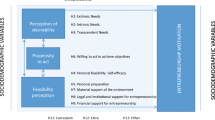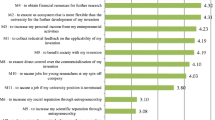Abstract
In this paper we propose a model to analyse the motivation of academic entrepreneurs that comprises six dimensions: personal, relating to the entrepreneurial opportunity, to scientific knowledge, to the availability of resources, to the incubator organization, and to the social environment. The model is tested based on information from a survey administered to 152 Spanish academic entrepreneurs. Our results show that entrepreneurial opportunity is not part of the entrepreneurial motivation, but is of the utmost importance to academic entrepreneurs. Also, we find the scientific knowledge is the main driver of entrepreneurial activity in the academia.


Similar content being viewed by others
Notes
In Spain, technology transfer activities in universities emerged in the 1990s making academic spin-offs an incipient phenomenon. Before 2000, there were only 17 spin-offs; since then there has been a significant increase in the number of academic spin-offs established, e.g. by 2006 there was a total of 530 spin-offs in Spain (RedOtri 2007).
The assessment scales process recommends assessing nomological validity. Scales show nomological validity of the constructs if the construct being measured is capable of demonstrating relationships with other constructs which, conceptually or theoretically, should exist (Vila et al. 2000). Accordingly, to assess this kind of validity it is necessary to have scales for several constructs, which is not the case here.
References
Anderson, J. C., & Gerbing, D. W. (1988). Structural equation modelling in practice: a review and recommended two-step approach. Psychological Bulletin, 103(3), 411–423.
Audretsch, D., & Kayalar-Erdem, D. (2004). Determinants of scientist entrepreneurship: An integrative research agenda. Discussion papers on entrepreneurship, growth and public policy, No. 2004-42, Max Planck Institute of economics, group for entrepreneurship, growth and public policy.
Autio, E., & Kauranen, I. (1994). Technologist-entrepreneurs versus non-entrepreneurial technologists: analysis of motivational triggering factors. Entrepreneurship y Regional Development, 6, 315–328.
Bentler, P. (1989). EQS structural equations program manual. Los Angeles: University of California.
Bentler, P., & Bonett, D. (1980). Significance tests and goodness-of-fit in the analysis of covariance structures. Psychological Bulletin, 88, 588–600.
Birley, S., & Westhead, P. (1994). A taxonomy of business start-up reasons and their impact on firm growth and size. Journal of Business Venturing, 9, 7–31.
Carayannis, E. G., Rogers, E. M., Kurihara, K., & Allbritton, M. M. (1998). High-technology spin-offs from government R&D laboratories and research universities. Technovation, 18(1), 1–11.
Carter, N. M., Gartner, W. B., Shaver, K. G., & Gatewood, E. J. (2003). The career reasons of nascent entrepreneurs. Journal of Business Venturing, 18, 13–39.
Cassar, G. (2007). Money, money, money? A longitudinal investigation of entrepreneur career reasons, growth preferences and achieved growth. Entrepreneurship and Regional Development, 19, 89–107.
Chiesa, V., & Piccaluga, A. (2000). Exploitation and diffusion of public research: the chase of academic spin-offs companies in Italy. R & D Management, 30(4), 329–339.
Chrisman, J., Hynes, T., & Fraser, S. (1995). Faculty entrepreneurship and economic development: the case of the University of Calgary. Journal of Business Venturing, 10(4), 267–281.
Cooper, A. C. (1985). The role of incubator organizations in the founding of growth-oriented firms. Journal of Business Venturing, 1(1), 75–86.
Cooper, A., & Gimeno-Gascón, F. (1992). Entrepreneurs, processes of founding, and new firm performance. In D. L. Sexton & J. D. Kasarda (Eds.), The state of the art of Entrepreneurship (pp. 45–67). Boston: PWS-KENT.
DiGregorio, D., & Shane, S. (2003). Why some universities generate more start-ups than others? Research Policy, 32, 209–227.
Ding, W., & Stuart, T. (2006). When do scientists become entrepreneurs? The social structural antecedents of commercial activity in the academic life sciences. American Journal of Sociology, 112(1), 97–144.
Doutriaux, J. (1991). University culture, spin-off strategy, and success of academic entrepreneurs at Canadian universities. In: Proceedings of Frontiers of Entrepreneurship Research, Babson College Conference, 406–421.
Doutriaux, J., & Dew, G. (1992). Motivation of academic entrepreneurs and spin-off development: analysis of regional and university effects through case studies. In: Proceedings of Frontiers of Entrepreneurship Research, Babson College Conference, 231–232.
Doutriaux, J., & Peterman, D. (1982). Technology transfer and academic entrepreneurship. In: Proceedings of Frontiers of Entrepreneurship Research, Babson College Conference, 430–448.
Dubini, P. (1988). The influence of motivations and environment on business start-ups: some hints for public policies. Journal of Business Venturing, 4, 11–26.
Etzkowitz, H. (1998). The norms of entrepreneurial science: cognitive effects of the new university—industry linkages. Research Policy, 27(8), 823–833.
Franzoni, C., & Lissoni, F. (2006). Academic entrepreneurship, patents and spin-offs: Critical issues and lessons for Europe. Centro di Ricerca sui Processi di Innovazione e Internazionalizzazione CESPRI, Università Commerciale Luigi Bocconi. Working Paper No. 80.
Gartner, W. B. (1988). Who is an Entrepreneur? Is the wrong question. American Journal of Small Business, 12(4), 11–32.
Hair, H. F., Anderson, R. E., Tatham, R. L., & Black, W. C. (1999). Análisis multivariante. Madrid: Prentice Hall.
Henrekson, M., & Rosenberg, N. (2000). Incentives for academic entrepreneurship and economic performance: Sweden and the United States. The Journal of Technology Transfer, 26(3), 207–231.
Jones-Evans, D. (1998). Universities, technology transfer and spin-off activities—academia entrepreneurship in different European Regions. Targeted Socio-economic Research Project No. 1042. Final Report. University of Glamorgan, Business School, and European Commission. http://www.lambertreview.org.uk/pdffiles/uni/utheschoolforbusinandregiondevelreport.pdf.
Kassicieh, S., Radosevich, R., & Banbury, C. (1997). Using attitudinal, situational, and personal characteristics variables to predict future entrepreneurs from national laboratory inventors. IEEE Transactions on Engineering Management, 44(3), 248–257.
Klofsten, M., & Jones-Evans, D. (2000). Comparing academic entrepreneurship in Europe. Small Business Economics, 14(4), 199–309.
Landry, E., Amara, N., & Rherrand, I. (2006). Why are some university researchers more likely to create spin-offs than others? Evidence from Canadian universities. Research Policy, 35(10), 1599–1615.
Laukannen, M. (2003). Exploring academic entrepreneurship: drivers and tensions of university based business. Journal of Small Business and Enterprise Development, 10(4), 372–382.
Lehrer, M., & Asakawa, K. (2004). Pushing scientists into the marketplace: promoting science entrepreneurship. California Management Review, 46(3), 55–76.
Levin, S., & Stephan, P. (1991). Research productivity over the life cycle: evidence for academic scientists. The American Economic Review, 81(1), 114–130.
Lockett, A., Siegel, D., Wright, M., & Ensley, M. (2005). The creation of spin-off firms at public research institutions: managerial and policy implications. Research Policy, 34, 981–993.
Louis, K., Blumenthal, D., Gluck, M., & Stoto, M. (1989). Entrepreneurs in academe: behaviours among life scientist. Administrative Science Quarterly, 34(1), 110–131.
McClelland, D. C. (1961). The achievement society. Princenton, N.J: Von Nostrand.
Meyer, M. (2003). Academic entrepreneurs or entrepreneurial academics? Research-based ventures and public support mechanisms. R&D Management, 33(2), 107–115.
Mosey, S., & Wright, M. (2007). From human capital to social capital: a longitudinal study of technology-based academic entrepreneurs. Entrepreneurship, Theory and Practice, 31(6), 909–935.
Nunnally, J., & Bernstein, I. (1994). Psychometric theory (3rd ed.). New York: McGraw-Hill.
O’Shea, R., Allen, T., Morse, K., O’Gorman, C., & Roche, F. (2004). Universities and technology transfer: a review of academic entrepreneurship literature. Irish Journal of Management, 25(2), 11–29.
Radosevich, R. (1995). A model for entrepreneurial spin-offs from public technology sources. International Journal Technological Management, 10(7/8), 879–893.
RedOtri de Universidades. (2007). Informe Red OTRI de Universidades, 2007. Conferencia de Rectores de las Universidades Españolas, CRUE, Madrid.
Roberts, E. (1991). Entrepreneurs in high technology: Lessons from MIT and Beyond. New York: Oxford University Press.
Samsom, K., Gurdon, M. (1990). Entrepreneurial scientist: organizational performance in scientist-started high technology firms. In: Proceedings of Frontiers of Entrepreneurship Research, Babson College Conference, 437–451
Searle, C. (2006). Academic capitalism and university incentives for faculty entrepreneurship. Journal of Technology Transfer, 31, 227–239.
Segal, G., Borgia, D., & Schoenfeld, J. (2005). The motivation to become an entrepreneur. International Journal of Entrepreneurial Behaviour and Research, 11(1), 42–57.
Shane, S. (2004). Academic entrepreneurship: University Spinoffs and wealth creation. Massachusetts: Edwar Elgar.
Shane, S., & Khurana, R. (2003). Bringing individuals back in: the effects of career experience on new firm founding. Industrial and Corporate Change, 12(3), 519–543.
Shane, S., & Venkataraman, S. (2000). The promise of entrepreneurship as a field of research. Academic of Management Review, 25(1), 217–226.
Shane, S., Kolvereid, L., & Westhead, P. (1991). An exploratory examination of the reasons leading to new firm formation across country and gender. Journal of Business Venturing, 6, 431–446.
Shane, S., Locke, E., & Collins, C. (2003). Entrepreneurial motivation. Human Resource Management Review, 13(2), 257–279.
Shapero, A. (1984). The entrepreneurial event. In C. A. Kent (Ed.), The environment for entrepreneurship. Massachussets: Lexington Books D.C. Heath and Company Lexington.
Steffensen, M., Rogers, E. M., & Speakman, K. (2000). Spin-off from research centers at a research university. Journal of Business Venturing, 15(1), 93–111.
Stephan, P. (1996). The economics of science. Journal of Economic Literature, 34(3), 1199–1235.
Vila, N., Küster, I. & Aldás, J. (2000). Desarrollo y validación de escalas de medida en Marketing, Quadern de Treball, n 104 (nova època), Facultat d`Economia, Universitat de València.
Vohora, A., Wright, M., & Lockett, A. (2004). Critical junctures in the development of university high technology spinout companies. Research Policy, 33(1), 147–175.
Weatherston, J. (1995). Academic Entrepreneurs: Is a spin-off Company too risky?. International Council for Small Business (ICSB). http://www.sbaer.uca.edu/research/icsb/1995/pdf/20.pdf.
Wright, M., Clarysse, B., Mustar, P., & Lockett, A. (2007). Academic entrepreneurship in Europe. United Kingdom: Edward Elgar.
Zhang, J. (2006). A study of academic entrepreneurs using venture capital data. Institute for the Study of Labor (IZA), IZA Discussion Papers No. 2992.
Author information
Authors and Affiliations
Corresponding author
Additional information
This paper is the outcome of Project GV PRE 2008/0176 funded by The Generalitat Valenciana (Government of the Valencia Region), Spain.
Rights and permissions
About this article
Cite this article
Morales-Gualdrón, S.T., Gutiérrez-Gracia, A. & Roig Dobón, S. The entrepreneurial motivation in academia: a multidimensional construct. Int Entrep Manag J 5, 301–317 (2009). https://doi.org/10.1007/s11365-009-0113-8
Published:
Issue Date:
DOI: https://doi.org/10.1007/s11365-009-0113-8




